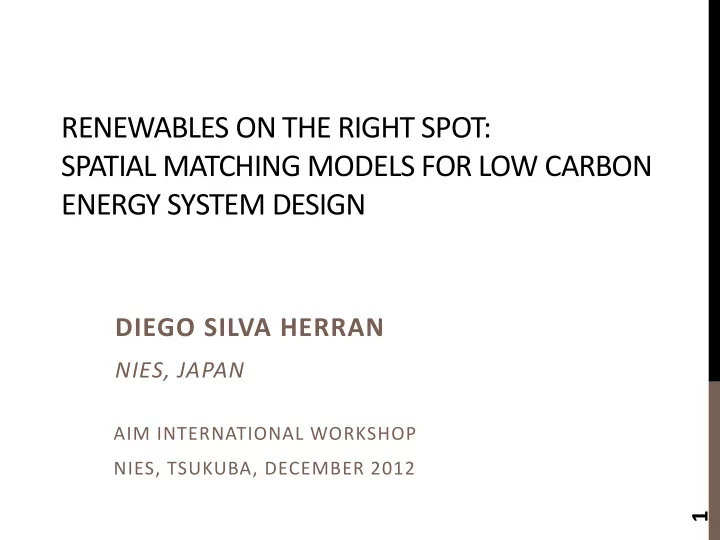

RENEWABLES ON THE RIGHT SPOT: SPATIAL MATCHING MODELS FOR LOW CARBON ENERGY SYSTEM DESIGN DIEGO SILVA HERRAN NIES, JAPAN AIM INTERNATIONAL WORKSHOP NIES, TSUKUBA, DECEMBER 2012 1
CONTENTS Introduction: “Renewables on the right spot” Outline of research Description of models • Global renewable energy potential model: protected areas, supply-cost curves, spatial matching. • Local energy system model: plant location, resource allocation. Future steps in research 2
INTRODUCTION: “RENEWABLES ON THE RIGHT SPOT” 3
WHY IS NEEDED? PURPOSE? Source: Asia LCS Research Project leaflet (NIES, 2011) Global emissions Low carbon (BAU scenario) Global emissions society/energy (LCS scenario) system Mitigation contribution (Asia) Renewable Asia emissions (LCS energy Renewables scenario) targets Aspects in assessment of resource potential Energy system Resource flow Efficiency of Resource technologies Cost Technology Spatial Location matching Demand Other 4
OUTLINE OF RESEARCH Renewable energy supply using GIS (gridded) data Global technical potential • Outputs: technical potential world x35 regions, supply cost curves, maps • Contribution: integrated models considering renewables, S-6 project Local energy system model using renewables • Outputs: optimal mix of renewables in local region, • Contribution: feasibility of renewable energy targets to policy makers in local areas, Iskandar Malaysia (SATREPS project) Population Protected areas Urban areas Global GHG Resource availability (Potential) Renewables Local Past 2010 2050 2100 Local area features 5 Renewable energy system
GLOBAL RENEWABLE ENERGY POTENTIAL MODEL Technical energy potential Quantity Theoretical potential Renewable energy Resource specific Spatial restrictions restrictions • Solar radiation: solar PV - Access (wilderness) Technology specific • Wind speed: onshore wind turbines restrictions - Conservation • Forest biomass (natural growth, residues): - Geographic Technical potential direct combustion in boilers 35 world regions (focus on Asia) Area Input Output Parameters Aggregated Restriction boundaries Potential Land suitability Renewable Energy Cost Yields Potential Model Cost-supply curve General data Maps Regions Potential Grid area Geo-referenced (GIS) data Resource specific data Resource data General data Wind power curve Insolation Land cover Forest removals Wind speed Slope Panel inclination Altitude angle Wilderness 6
ACCOUNTING FOR NATURAL CONSERVATION (PROTECTED AREAS) “Loss” in technical potential [MWh/yr] Solar PV = 11% Onshore wind = 10% Forest biomass = 17% 7
SUPPLY (POTENTIAL) COST CURVES 0.30 JPN CHN 0.25 IND Energy supply IDN KOR 0.20 Unit cost [USD/kWh] THA (technical potential) [TWh/yr] MYS 0.15 VNM Unit electricity costs [USD/kWh] XSE PHL 0.10 SGP XSA 0.05 XEA TWN XCS 0.00 0.40 XME 0.4 - 1,000 2,000 3,000 4,000 5,000 6,000 7,000 8,000 9,000 Technical potential - Solar PV electricity [TWh/yr] JPN 0.35 CHN Solar PV IND 0.3 Onshore wind Unit cost [USD/kWh] 0.30 IDN Forest KOR Unit cost [USD/kWh] 0.25 THA 0.2 MYS 0.20 VNM XSE 0.15 0.1 PHL SGP 0.10 XSA 0 XEA 0.05 - 20,000 40,000 60,000 80,000 100,000 TWN Technical energy potential [TWh/yr] XCS 0.00 XME - 1,000 2,000 3,000 4,000 5,000 6,000 7,000 8 Technical potential - Onshore wind electricity [TWh/yr]
SPATIAL MATCHING IN GLOBAL TECHNICAL POTENTIAL Spatial matching = Proximity to urban areas Threshold for distance to urban areas; Transmission losses Solar PV and onshore wind electricity generation Neglect current electricity transmission networks (grids) INPUT OUTPUT Technical potential Land cover Technical potential (urban) GIS (grid cell) with spatial model matching Distance (urban areas) threshold Transmission losses 9
SPATIAL MATCHING IN GLOBAL TECHNICAL POTENTIAL Technical potential of PV and Wind down by 12% and 15% in China 6,000 TD_Loss TDMax 5,000 Electricity supply [TWh/yr] Net potential Elec.dmd. 4,000 3,000 2,000 1,000 0 Japan China India Japan China India Solar PV Onshore wind 10
LOCAL ENERGY SYSTEM MODEL USING RENEWABLES Technology (plant site) location + Resource allocation Optimization: MIP (mixed integer programming) Objective function: Minimize Total cost Solved using GAMS (General Algebraic Modeling System) INPUT OUTPUT GIS data Plant location Renewable Energy Supply - Coordinates energy potential Potential - Map model Optimization model Fixed costs Energy mix Distance-to- - Min Cost - Rsc. allocation Closest-Feature - s.t. Constraints - Spl. allocation Distance ( DistCF ) tool Energy system Scalars performance Demand (target) - Costs Variable costs - Area 11 Structure of local energy system model
LOCAL ENERGY SYSTEM MODEL – OUTCOMES Demand = 550 GWh (i.e. 5% electricity demand) • PV supply = 91 % (1,941-1,981 MWh/yr/cell) • Wind supply = 9 % (73 MWh/yr/cell) Demand = All forest potential (157 GWh) Solar PV + Wind = 5% elec.demand • 1.5% of electricity demand 0.40 10 0.35 8 0.30 CO 2 Emissions reduction [%] Unit cost [USD/kWh] 0.25 6 0.20 4 0.15 0.10 2 0.05 12 0.00 0 Forest biomass = 100% forest potential - 100 200 300 400 500 600 Energy supply target [GWh/yr]
FUTURE STEPS Spatial matching in global model • Proximity to urban areas: Impact on costs? • Incorporate population and consumption per capita data • Deployment of renewables based on spatial matching: On-site vs off-site • Load (electricity demand) matching: compare size of supply and demand for locating plants Spatial matching in local model • Generic model formulation • Incorporate detailed data: land use, renewable resources • Model application to other regions in Asia Focus on biomass • Energy crops Dynamic aspects of renewable supply • Scenarios (e.g. land use) 13
THANK YOU VERY MUCH! COMMENTS AND QUESTIONS ARE WELCOME! 14
Recommend
More recommend